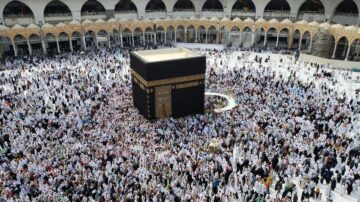Imagine a woman left alone with an infant with no sufficient provision and where? In a completely barren land!
Lady Hajar, Prophet Ibrahim’s wife, sacrificed her safe home where she used to live; sacrificed being in a company with other people; sacrificed even a safe place for her only infant! For what was all this? For Allah’s sake! She gave priority to Allah’s orders over her own needs.
The story of Lady Hajar and her desperate search for water for her infant son Isma`il when they were left in the desert by Prophet Ibrahim in response to a divine vision is a symbol of sacrifice and altruism.
Prophet Ibrahim (peace and blessings be upon him) brought her, and her son Ismail, whom she was still nursing, and left them at (the site of) the House of Allah under a tree above the place where Zamzam emerged. At that time, Makkah was a barren place. There was neither water nor any people inhabiting it. He left a bag of dates and a container of water for them. Then Ibrahim (peace and blessings be upon him) turned to leave. Ismail’s mother said to him, “O Ibrahim! Where are you going? And who are you leaving us to in this valley without anything or any companion?” She repeated this several times but he did not respond. At last she asked him, “Has Allah commanded you to do so?” He answered, “Yes.” Thereupon she said, “Then He will not let us perish!” (Al-Bukhari) In another narration we read: “She asked him, ‘Who are you leaving us to?’ He answered, ‘To Allah,’ whereupon she responded, ‘I am satisfied,’ and she turned back.
Ibrahim left and when he reached a mountain pass where he could no longer see them, he turned his face toward the Ka`bah and raised his hands in supplication, (O Our Lord! I have made my offspring to dwell in a valley without cultivation by Your Sacred House, in order Our Lord, that they may establish regular prayer: so fill the hearts of some among men with love towards them, and feed them with fruits, so that they may give thanks!) (Ibrahim 14:37)
Hajar sat under the tree with her baby next to her. She drank from her water container, which was hanging nearby, and nursed her baby, until all the water she had was gone, and her milk dried up. Her son grew hungrier and hungrier, and she could hardly bear to look at him. She went and stood at Safa – the hill nearest to her. She looked down the valley to see if there was anyone around to help. She could see no one, so she climbed down Safa to the valley. She struggled hard, crossed the valley and reached Marwah. She stood at the top of Mount Marwah, and looked around. Still she could see no one around. She repeated this seven times.
“When she reached the Marwa (for the last time) she heard a voice and she asked herself to be quiet and listened attentively. She heard the voice again and said, ‘O, (whoever you may be)! You have made me hear your voice; have you got something to help me? She saw an angel at the place of Zamzam, digging the earth with his heel (or his wing), till water flowed from that place. She started to make something like a basin around it, using her hand in this way, and started filling her water-skin with water with her hands, and the water was flowing out after she had scooped some of it.” (Al-Bukhari)
The Pilgrims’ Sa`i ( Arabic for the devotional act of walking seven times back and forth between the two hills of Safa and Marwah) retraces the footsteps of Hajar. It is to commemorate this great story of sacrifice. But commemoration here should not be confined to the physical effort Lady Hajar exerted for searching for water. It should also extend to the spiritual strength and model of sacrifice she showed in this eternal story.
By Samah Abdel-Hakam

